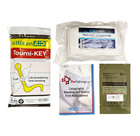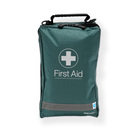Horizontal sling
Unlock This Video Now for FREE
This video is normally available to paying customers.
You may unlock this video for FREE. Enter your email address for instant access AND to receive ongoing updates and special discounts related to this topic.
How to Apply a Horizontal Sling for Arm Injuries
Introduction to Horizontal Slings
A **horizontal sling** is used to immobilise an arm with a suspected or confirmed fracture. Unlike an elevated sling, the horizontal sling does not lift the arm, which helps prevent additional strain on the injury. This guide will walk you through the steps to correctly apply a horizontal sling and offer tips for additional immobilisation if needed.
Step 1: Preparing the Sling
Before applying the sling, you may choose to stabilise the arm with a splint. **Splints can be made from various materials**, including paper, cardboard, or commercial splints. However, for this training example, we will focus solely on applying the sling.
To begin, open the sling and locate the corners: the 90-degree corner and the 45-degree corner. The 90-degree corner will be positioned at the elbow.
Step 2: Applying the Horizontal Sling
Follow these steps to apply the horizontal sling:
- Place the 90-degree corner of the sling underneath the injured arm, ensuring the corner is at the elbow.
- Bring the sling up and around the back of the head, tying the ends securely at the neck.
- Ensure the knot is tight to prevent the sling from coming undone, and allow the injured arm to rest comfortably in the sling.
- Check that the sling is open on the side near the hand; this ensures that the arm is fully supported and cannot slip out.
Step 3: Additional Immobilisation
If the injury involves a dislocated shoulder or if further immobilisation is required, you can add a second bandage for additional support:
- Create a broad-fold bandage by holding the two 45-degree corners and rolling the fabric.
- Tuck this bandage underneath the uninjured arm, bringing it across the chest.
- Secure the bandage by tying it on the injured side, which will help keep the arm close to the body and prevent movement that could strain the shoulder.
Final Considerations
The **horizontal sling** is an effective way to immobilise an injured arm, especially when dealing with fractures, dislocations, or sprains. By following these steps, you can ensure that the injury is stabilised and the risk of further harm is minimised. Always seek professional medical assistance after applying a sling to ensure proper treatment.




_-Trauma_8x20_CE.jpg)


